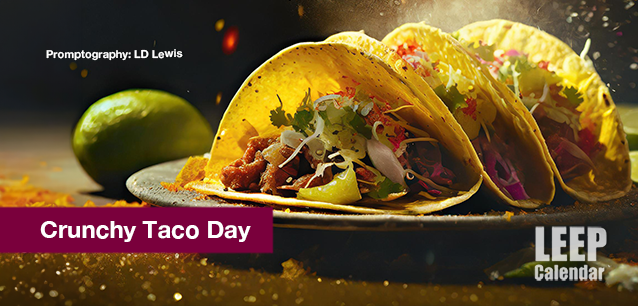 AD
AD
Today is: December 02
Scroll to explore events active on this date.
Additional Events on LEEP
LEEP INK FEATURES

August? Absolutely!
In August, we live through the Dog Days of Summer. It's hot and often humid, and those who can leave for better climates do. Down south, winter is in full force. August is also known as "the ...

In The Heat of July: July 2025 Events
Is it hot enough (or cold enough if you're below the equator) for you yet? There is actually a day for that! Like every month, I pick a diverse collection of events you may or may not know about. This ...

May Blooms: Events in May 2025
Along with October, May is one of the most densely packed months of the year. It's before the summer humidity and the last whole month of the school year. The weather is warming in t...
About Crunchy Taco Day
Ends: Mar 21, 2025
DESCRIPTION:
CRUNCHY TACO DAY
The crunchy taco shell, a staple of Mexican-American cuisine, has a history that intertwines innovation with cultural adaptation. Tracing its origins requires a journey back to the late 19th century when Mexican food began to make its indelible mark on the American culinary landscape. The transformation of the traditional soft corn tortilla into a crispy taco shell is a testament to the ingenuity of Mexican immigrants and entrepreneurs who adapted their culinary traditions to suit American tastes and lifestyles.
Glen Bell, the founder of Taco Bell, was one pivotal figure in popularizing the crunchy taco shell. In the 1950s, Bell began experimenting with pre-frying taco shells to make them crisp, a technique allowing quicker service, a less messy product, and more convenience for American consumers. This innovation transformed the taco and laid the groundwork for the fast-food taco industry.
Before Bell's innovation, tacos were traditionally served with soft corn or flour tortillas. The concept of frying a taco shell until it was hard was a departure from this tradition, designed to extend the shelf life of the tortilla and make the taco easier to eat by hand. These qualities appealed to the American way of eating. This adaptation was with its critics, as some purists argued it strayed too far from the taco's roots. Nonetheless, the crunchy taco shell became a beloved fixture in American cuisine.
The rise of the crunchy taco shell coincided with a growing interest in Mexican cuisine in the United States, fueled by the nation's changing demographics and the increasing cultural exchange between the two countries. Mexican restaurants, many of them started by Mexican-American families, began to increase across the U.S., serving both traditional dishes and new creations like the crunchy taco. These establishments played a crucial role in introducing Mexican food to a broader American audience, blending authenticity with innovation.
The crunchy taco shell's popularity was further boosted by the expansion of Mexican fast-food chains in the latter half of the 20th century. With Taco Bell leading, these chains brought Mexican-inspired food to every corner of the country, making the crunchy taco a familiar and accessible option for Americans from all walks of life. The success of these chains highlighted the American public's appetite for Mexican flavors, albeit in a form adapted to suit their tastes.
Today, the crunchy taco shell is recognized as a quintessentially Mexican-American invention that reflects the broader story of immigration, adaptation, and cultural exchange. While it may have strayed from its traditional roots, the crunchy taco shell symbolizes how cuisines can evolve and blend to create new culinary traditions. Its history is a reminder of the power of food to bridge cultures, adapting to new environments while still paying homage to its origins.
VIDEOS
SUPPORTING DOCUMENTS
Currently, this event does not have supporting documents.
ADDITIONAL IMAGES
Currently, this event does not have supporting images.
Where would you like to go now?
 AD
AD


/footer-logo.svg)
